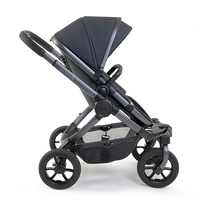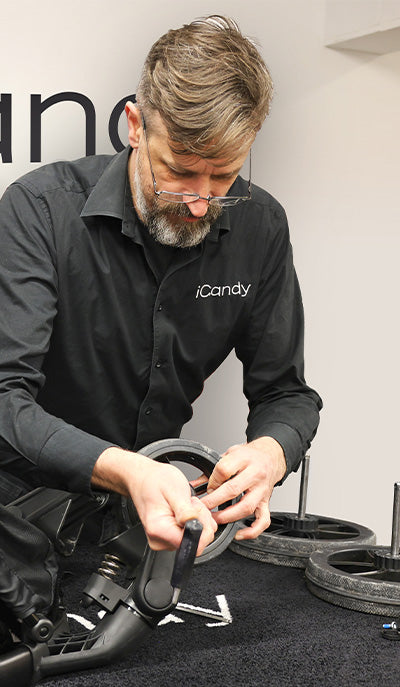

Step-by-step Pushchair Cleaning Guide
Important: Always follow the manufacturer's instructions when using cleaning products. Exercise caution and verify that the products are safe for use around children and on items intended for children. Additionally, ensure compatibility with the material being cleaned. Conduct spot checks on inconspicuous areas before full application.
Stage 1: Pre-Cleaning Assessment
- Begin by assessing the extent of dirt, stains, mud, and mould on your pushchair.
- Identify any specific areas that require special attention, such as fabric stains, wheel grime, or mould growth.
Stage 2: Brushing and Vacuuming
- Use a soft-bristled brush to gently loosen any dried mud or debris from the fabric and crevices of the pushchair.
- Vacuum the pushchair thoroughly to remove loose dirt, crumbs, and dust from all surfaces, including the seat, canopy, and basket.
Stage 3: Spot Cleaning
- Prepare a gentle cleaning solution using warm water and mild baby-safe detergent or a mixture of vinegar and water (1:1 ratio) in a spray bottle.
- Test the cleaning solution on a small, inconspicuous area of the pushchair to ensure it does not cause discolouration or damage.
- Spray the solution onto stained or soiled areas of the pushchair and gently scrub with a soft-bristled brush or clean cloth.
- Rinse the cleaned areas with a damp cloth to remove any remaining soap residue.
- Allow the pushchair to air dry completely before use.
Stage 4: Mould Removal
- If mould is present on any part of the pushchair, mix equal parts of water and white vinegar in a spray bottle.
- Spray the affected areas generously with the solution and allow it to sit for 10-15 minutes to penetrate the mould.
- Scrub the mouldy areas with a soft brush or sponge until the mould is completely removed.
- Rinse the cleaned areas thoroughly with water and wipe dry with a clean cloth.
- For stubborn mould stains, consider using a specialised mould remover product recommended for use on baby products, following the manufacturer's instructions carefully.
Stage 5: Wheel Cleaning
- Remove any excess dirt or debris from the wheels using a soft-bristled brush or a damp cloth.
- Apply a small amount of mild detergent solution to the wheels.
- Scrub the wheels thoroughly with a brush, paying attention to grooves and crevices where dirt may accumulate.
- Rinse the wheels with clean water to remove the detergent residue.
- Wipe the wheels dry with a clean cloth.
- Inspect the wheels for any remaining dirt or grime, repeating the cleaning process if necessary.
- Once cleaned, ensure the wheels are completely dry before reattaching them to the pushchair.
This additional stage ensures that the wheels, which often accumulate significant dirt and grime, receive proper attention and cleaning, maintaining the overall cleanliness and functionality of the pushchair.
Stage 6: Frame cleaning
- For aluminium frames: Use a mild detergent or soap with water and a soft cloth to wipe away dirt and grime. Avoid abrasive cleaners that may scratch the surface.
- For plastic components: A gentle cleanser or baby wipes can effectively clean plastic parts.
- Pay attention to corners, joints, and crevices where dirt can accumulate.
- Utilise small brushes or cotton swabs dipped in soapy water to reach these areas effectively.
- A toothbrush can also be handy for scrubbing hard-to-reach spots.
- After cleaning, rinse the frame with clean water to remove any remaining soap residue.
- Ensure the frame is completely dry before reassembly to prevent water damage or corrosion.
- Use a soft, dry cloth to speed up the drying process, especially in areas where water may pool.
This additional stage ensures that the wheels, which often accumulate significant dirt and grime, receive proper attention and cleaning, maintaining the overall cleanliness and functionality of the pushchair.
Stage 7: Maintenance and Preventative Measures
- Regularly clean your pushchair at least once a month, or more frequently if it's exposed to heavy use or severe weather conditions.
- Regular cleaning helps prevent the buildup of dirt, stains, and mould, preserving the appearance and functionality of your pushchair.
- Avoid using harsh chemicals, bleach, or abrasive cleaners on your pushchair, as they can damage the fabric, frame, and other components.
- Use only cleaning products specifically formulated for baby goods and follow the manufacturer's instructions for safe use.
- Proper maintenance and regular cleaning can extend the life of your pushchair, ensuring it remains safe and comfortable for your child's use.
By following these steps and guidelines, you can effectively clean your pushchair, remove common winter issues like stains, mud, and mould, and keep it looking and functioning like new for years to come.



















